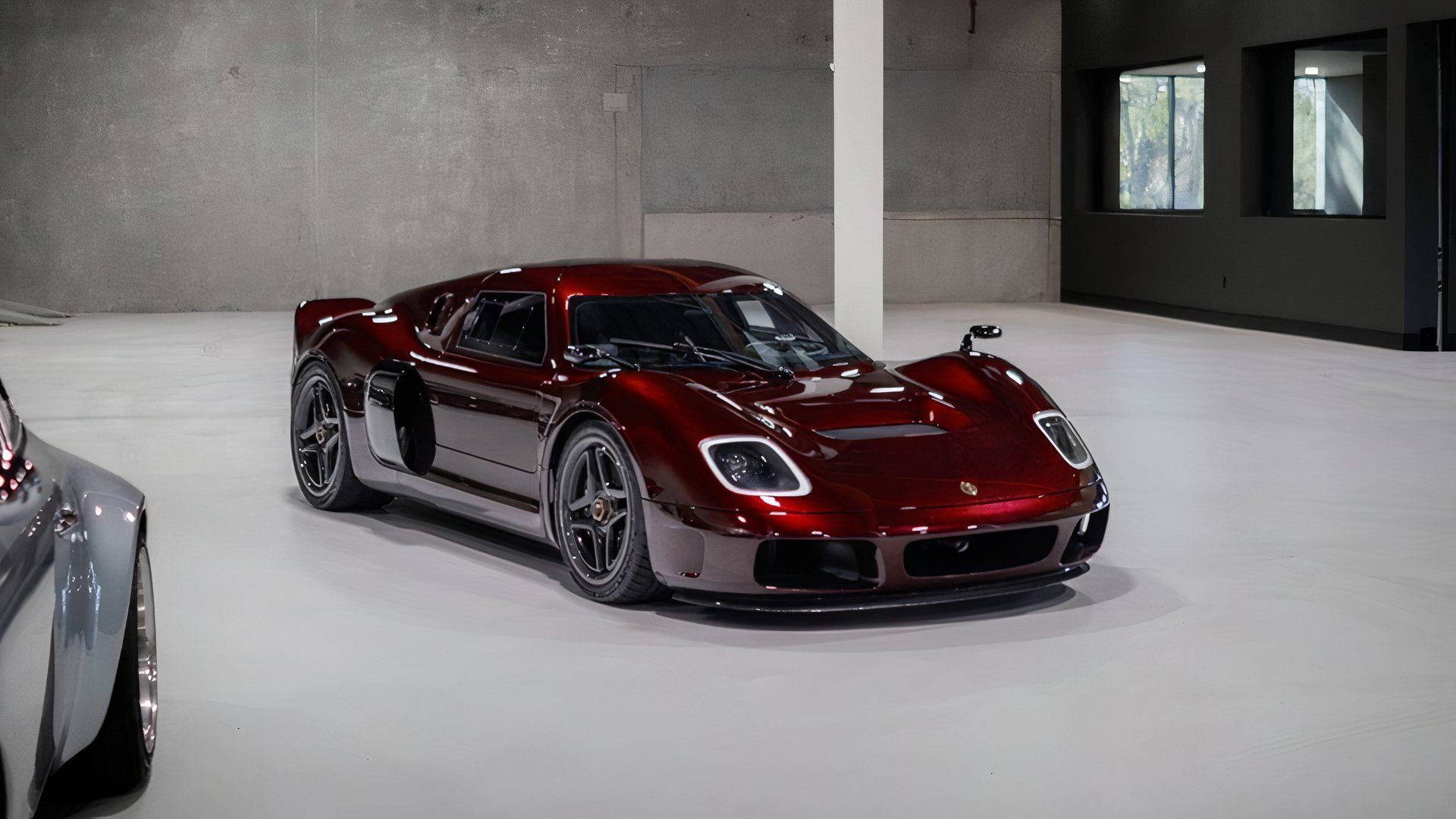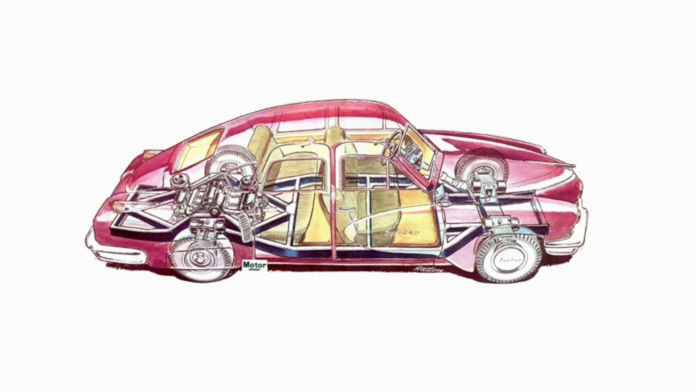Quick Links
-
A Look At The Helicopter-Sourced Franklin O-335 Engine
-
Why Did They Only Make Fifty Of These Cars?
“If I had a set of wings, man I know she could fly.” So sang Mike Love in the Beach Boys classic “Little Deuce Coupe.” Well, Preston Tucker was one step ahead of Mike back in the late 1940s, when he packed a helicopter engine into a sedan. The Tucker 48 might not have been able to take flight on a clear afternoon, but the short-lived muscle car would go on to become a favorite of director Francis Ford Coppola, becoming the subject of his biopic on the automaker, Tucker: The Man and His Dream.
The funny thing is, the helicopter engine was actually a last-resort option after multiple failed powerplants, and it doesn’t have much to do with the car’s abrupt demise. Here’s what you need to know about the Tucker 48.
The following overview is based on research into automotive history drawn from verified sources including archived newspaper and magazine articles, and books on automotive history.
The Tucker Torpedo
If you’ve ever heard of this car, you may have heard it called the “Tucker Torpedo.” That was a name used for the prototype, owing to the car’s projectile-like profile, but the title never made it to the production model. As the story goes, Tucker wanted this car to reflect post-war optimism, and he didn’t think it was a great idea to remind the American public of naval warfare, U-boats, and battleships.
|
Engine |
Franklin O-355 5.5-Liter Six-Cylinder |
|---|---|
|
Power |
166 hp |
|
Torque |
372 lb-ft |
|
Top Speed |
120 mph |
|
0-60 |
10 Seconds |
|
Drivetrain |
Rear-engine, Rear-wheel drive |
The post-war period was an exciting time for American automakers for a lot of reasons. One of which being that wartime rationing meant nobody was developing new cars while America was at war. So, with resources freed up and the availability of new technology developed during the war effort, you had the Studebaker, the Ford Skyliner, Civilian Jeeps, plus the American Federal-Aid Highway Act of 1956 was right around the corner. The Tucker 48 aimed to be an industry leader for the era, and it met all the qualifications for the job.
Related
The Craziest Car Engines That Never Made It To Production
Strange engine configurations that never reached production always makes for interesting reading. Here are our favorites.
It looked cool, leaning into a more modern vibe where the Big Three weren’t really taking any stylistic risks around that time, and the car was packed with innovative features. These included ergonomic cabin design, padded dashboards, shatterproof windshields, and even an early anti-theft device in the form of a secondary lock and key for the parking brake.
A Look At The Helicopter-Sourced Franklin O-335 Engine
Tucker promised 150 hp from the start, and cleared that goal by a good 16 horses, but it took a few tries to get there. Tucker started with a 589 CID six-cylinder, but they could only squeeze 88 hp out of the powerplant, owing to issues with the valve train. Next, they went to Lycoming Engines, an aircraft engine supplier, but they found that their engine wouldn’t even fit in the car. Finally, they came around to the Franklin O-335, an engine that powered dozens of helicopters throughout the 1940s, and the amphibious Goodyear Duck airplane.
|
Franklin O-335 Technical Specs |
|
|---|---|
|
Bore |
4.5 inches |
|
Stroke |
3.5 inches |
|
Displacement |
335 cu. in. |
|
Length x Width x Height |
37.4 x 30.8 x 21.6 inches |
The O-335 was first developed for military use, with the initial vertical-installation model cranking out 175 hp. The final version of the O-355 would eventually produce 225 hp at 3,200 rpm. The engine has been used in countless airplanes and helicopters, but it never found its way into another production car.
Tucker added a water cooling system to the helicopter engine, and it was actually situated right behind the rear wheels of the 48, not between them. The engine would be paired to the Tuckermatic transmission, a fully-automatic continuously-variable system developed with consultation from Buick Dynaflow creator Warren Rice.

Add CarBuzz to your Google News feed.
While the Tucker 48 would only produce a prototype plus fifty hand-made models, most of which were built in a decommissioned B-29 factory in Chicago, before the project was canceled and Tucker Motors had to file for bankruptcy, the silver lining to Tucker’s venture would be the acquisition of the Franklin Engine Company. The company would remain under the ownership of the Tucker family from 1947 to 1961, five years after Preston’s passing.
The engine maker would persist for another fourteen years under Aero Industries before being sold to the Polish government in 1975. The company still exists to this day under the name Franklin Aircraft Engines, with an outlet in Fort Collins, Colorado. Franklin engines remain a popular choice for experimental aircraft owing in large part to their relative quality for the price.
Why Did They Only Make Fifty Of These Cars?
Long story short? Preston Tucker was selling accessories before the car was even ready for production, with buyers guaranteed a coveted spot on the waiting list, and the US Securities and Exchange Commission didn’t like that. This caused a whole chain of events that would result in a lot of bad publicity and the company eventually filed for bankruptcy after only producing fifty Tucker 48s, even after Tucker had been acquitted on all counts.
According to Preston Tucker himself, it wasn’t outside the realm of possibility that the Big Three automakers had conspired with Michigan Senator Homer S. Ferguson to sabotage the Tucker 48. Coppola’s dramatized retelling of the scandal implicitly takes Preston’s side, arguing against the monopolization of American industry. While it can be argued that the Big Three probably didn’t want the competition, there’s no clear evidence that they had a direct hand in the end of Tucker Motors, and the more likely explanation may be that the company was standing on shaky financial ground. Preston didn’t want to take out business loans, and pre-selling accessories isn’t the best way to go about financing a production car.

Related
Iconic Supercar Manufacturer’s Revival Derailed By Fraud And Bankruptcy
British TV star Ant Anstead co-founded Radford Motors with former F1 World Champion Jenson Button, but now he’s being accused of fraud.
It’s fun to dwell on these conspiracy theories, but if GM, Chrysler, and Ford had been scheming with an American senator to kick the legs out from under a small automaker, someone probably would have written a tell-all book about it by now. The bottom line is that the auto industry is a tough business to break into, even for an innovator like Preston Tucker. Over the last couple of years alone there’s been no shortage of automakers filing for bankruptcy. Just ask Fisker, Lordstown, Arrival, Holden, Radford Motors, the list goes on. Innovative ideas and beloved products are no guarantee against an untimely demise.
The Tucker 48 lives on with a devoted fanbase, keeping the existing models in near-mint condition. Your chances of getting your hands on the real deal range from slim to none. Maybe if your grandpa happens to own one, and you stay in his good graces, and he decides not to be buried in it, then you might have a shot. The smarter move would be to keep an eye on the auction websites for one of the replicas created for the Coppola film, or just buy a fiberglass kit and build one yourself.
Sources:
Henry Ford
,
Tucker Automobile Club Of America

